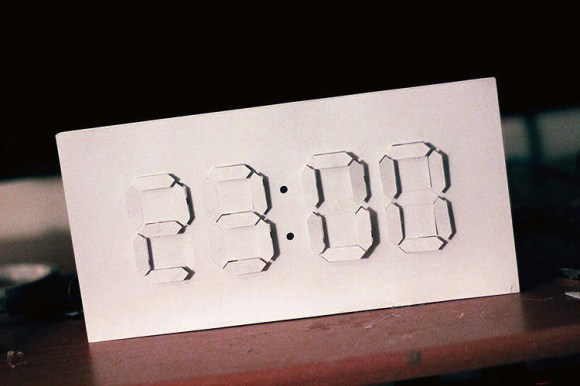
Segments rise from a sheer white surface to reveal the time in this papercraft digital / analog clock build by [Jacky Mok].
New York-based designer [Alvin Aronson] is responsible for the original, titled “D/A Clock,” which he built as a student at RISD using Corian instead of paper. [Aronson]’s design is also massive in comparison. It measures one meter wide by a half meter tall. Without access to either a 3D printer or to a laser cutter, [Jacky] instead reduces the scale of his interpretation and relies on cardstock as the primary construction material. His experience with papercraft typography leads to a design that anyone with an Exacto knife and a slice of patience should find manageable. [Jacky] ignores the Exacto option, however, and cuts his pieces with a tool we saw earlier this year: the Silhouette Portrait.
The clock’s electronics include an Arduino Uno, a servo motor controller, twenty-eight servos and an RTC breakout board that handles timekeeping. Each servo drives its own segment by sliding a paperclip forward or backward inside a small, hollow aluminum rod. Though we’re still holding out for a video of the finished papercraft build, you can watch a video of Aronson’s original clock after the break and see what inspired [Jacky’s] design.
Need another clock to envy? Last month’s build by [ebrithil] uses twenty-two servos to individually spin the segments. If you prefer that your clocks light up, [Aaron’s] o-scope transformation has you covered.















I feel like with some clever hacking we could reduce the number of servos
Why not linear actuators? When would you need a half extended digit…
Perhaps you mean solenoids; but I agreed that servos are overly complex.
Solenoids tend to need more power and are more or at best equally expensive though, so what’s the advantage?
I would love to see a seconds spot on this clock. It is crazy how the paper fades with the rest of the paper and boom you got some new digits.
That fade effect messes with my head! Fantastic!
What about solenoids or hacked relays?
I feel like they should have used solenoids or something, but then I remembered that HXT-900 servos cost $2.69 and you get so much more control over them / don’t need to build any power circuitry. I think it would be difficult to find relays and make drivers for them for that price and have the ability to do slow changeovers / easily adjustable travel.
I like the fading that’s possible with the servo’s…
The paper clock could have some accent lighting in one (or more) of the corners to add color and increase shadow contrast
Clocks. the “Hello World” of hardware hacking. ;-)
I thought flashing an LED was the “hello world” of hardware hacking?
Can be done with four servo, same fading effect.
This principle could be usefull for 3D Projection Mapping. Being able to raise and lower various paterns on the wall could make for some interesting effects using a similar method to this:
http://www.blendernation.com/2012/09/13/blender-in-3d-projection-mapping/